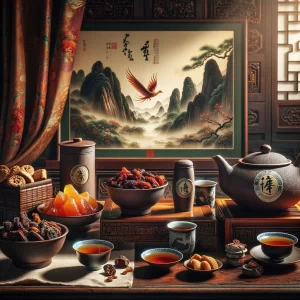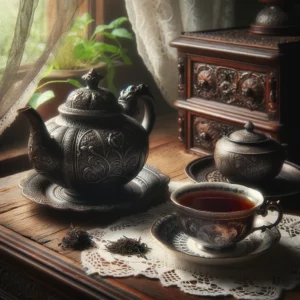Phoenix Dancong Oolong Tea is a unique and aromatic delight that originates from the misty peaks of the Phoenix Mountains in China. This tea is renowned for its rich history, intricate cultivation, and the exceptional skill required in its processing. Its complex flavor profile, which can range from floral to fruity, depending on the specific bush varietal, has captivated tea lovers worldwide. In this blog post, we’ll dive deep into the world of Phoenix Dancong Oolong Tea, exploring its origins, what makes it so special, and how you can enjoy it to the fullest. Whether you’re a seasoned tea aficionado or just beginning your tea journey, there’s something about Phoenix Dancong Oolong Tea that is sure to enchant and intrigue.
Table of Contents
- The Origins and History
- What Makes Phoenix Dancong Oolong Tea Special?
- Brewing the Perfect Cup
- Ways to Enjoy Phoenix Dancong Oolong Tea
- The Best Pairings for Phoenix Dancong Oolong Tea
- Where to Find Phoenix Dancong Oolong Tea and How to Store It
- Cultivation and Processing
- Conclusion
The Origins and History
Phoenix Dancong Oolong Tea, with its roots deep in the Guangdong province of China, is a tea with a story as rich as its flavor. The name “Dancong” originally meant “single bush,” referring to the tea’s traditional method of cultivation where each tea came from a single tea bush, believed to produce a distinct flavor. These teas are cultivated on the Phoenix Mountains, a region with a perfect climate and fertile soil for growing the unique varietals of the Dancong tea bush.
Historians trace the tea’s origins back hundreds of years, with some stories suggesting it was a tribute tea to the imperial families of China. Over time, the tea gained popularity for its exquisite flavor and fragrance, making it a cherished choice among tea connoisseurs around the world.
What Makes Phoenix Dancong Oolong Tea Special?
What sets Phoenix Dancong Oolong Tea apart is its incredibly diverse flavor profile, which can vary greatly from one bush to another. Each varietal offers a unique taste – some have a sweet, floral aroma, while others might hint at fruit, honey, or even spices. This diversity is a result of the tea’s unique cultivation methods, the specific conditions of the Phoenix Mountains, and the skilled processing it undergoes.
Phoenix Dancong Oolong Tea is also known for its “Yan Yun,” or rock rhyme, a term used to describe the tea’s lingering, mineral-rich aftertaste that resembles the taste of the mountain’s natural spring water. This characteristic, combined with its ability to evolve with each steeping, offering new layers of flavor, truly makes it a special brew.
Brewing the Perfect Cup
Brewing Phoenix Dancong Oolong Tea is an art form that requires attention to detail to bring out its best qualities. Here’s a simple guide to brewing the perfect cup:
- Water Temperature: Use water at about 195°F (90°C). This temperature extracts the flavors without scorching the leaves.
- Tea Quantity: Use about 5 grams of tea for every 8 ounces of water. This ratio ensures a well-balanced brew.
- Steeping Time: Start with a steeping time of 1-2 minutes for the first brew and adjust according to taste for subsequent brews. Phoenix Dancong can be re-steeped multiple times, with each steeping revealing a new dimension of flavor.
- Utensils: A traditional Chinese gaiwan or a clay teapot is recommended for brewing, as they enhance the tea’s natural flavors.
Ways to Enjoy Phoenix Dancong Oolong Tea
Phoenix Dancong Oolong Tea can be enjoyed in various ways, making it a versatile choice for any tea lover:
- Plain: Savoring it plain allows you to fully appreciate the complexity and depth of its flavors.
- With Additions: A splash of milk or a slice of lemon can add an interesting twist to the tea, highlighting different notes in its flavor profile.
- In Recipes: Incorporate Phoenix Dancong Oolong Tea into recipes, like tea-infused cakes or marinades, to add a unique flavor to your dishes.
The Best Pairings for Phoenix Dancong Oolong Tea
Pairing food with Phoenix Dancong Oolong Tea can enhance both the tea and the food’s flavors. Here are some pairing suggestions:
- Sweet Pastries: Complement the tea’s floral notes with light, sweet pastries or fruit tarts.
- Savory Dishes: Try it with grilled vegetables or poultry to balance the tea’s sweetness and depth.
- Cheese: Aged cheeses pair wonderfully with the complexity of Phoenix Dancong Oolong Tea.
Where to Find Phoenix Dancong Oolong Tea and How to Store It
Finding high-quality Phoenix Dancong Oolong Tea involves looking for reputable tea shops or online retailers specializing in Chinese teas. When selecting your tea, pay attention to the leaves’ appearance and aroma – they should be whole and fragrant.
Storing Your Tea: To maintain its freshness and flavor, store Phoenix Dancong Oolong Tea in an airtight container away from light, moisture, and strong odors. Proper storage can significantly prolong the life of your tea.
Cultivation and Processing
The cultivation and processing of Phoenix Dancong Oolong Tea are intricate processes that greatly influence its flavor. The tea is handpicked in the spring, when the leaves are at their aromatic peak. After plucking, the leaves undergo withering, rolling, oxidation, and finally, drying. This meticulous process, particularly the control of oxidation, is what gives Phoenix Dancong its unique character.
Conclusion
Phoenix Dancong Oolong Tea is a treasure of the tea world, offering an exquisite experience with every cup. Its rich history, unique flavor profiles, and versatile brewing options make it a fascinating subject for anyone interested in the art of tea. Whether you’re brewing a cozy cup for yourself or exploring its culinary applications, Phoenix Dancong Oolong Tea invites you to discover its many layers and nuances. Embark on your tea journey with Phoenix Dancong and let its flavors inspire you.
Try Phoenix Dancong Oolong Tea
“As an Amazon Associate I earn from qualifying purchases.”
[azonpress template=”grid” asin=”B0CTZS9CVQ,B0855ZV9CF,B089RB5LL9,B0DZST9X32″]



